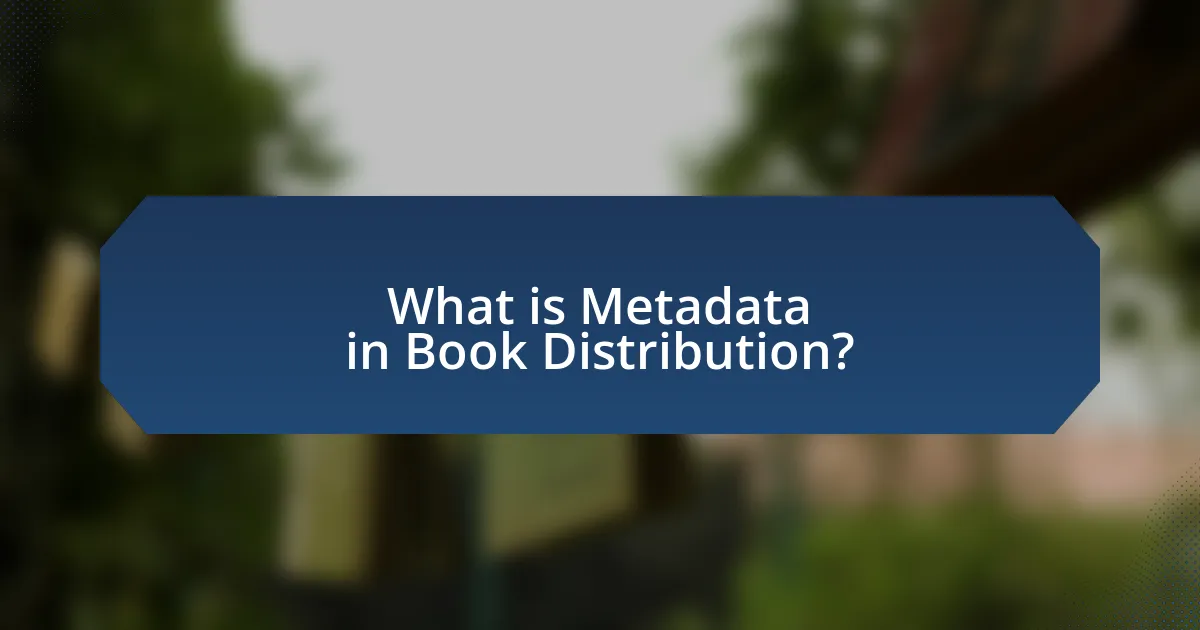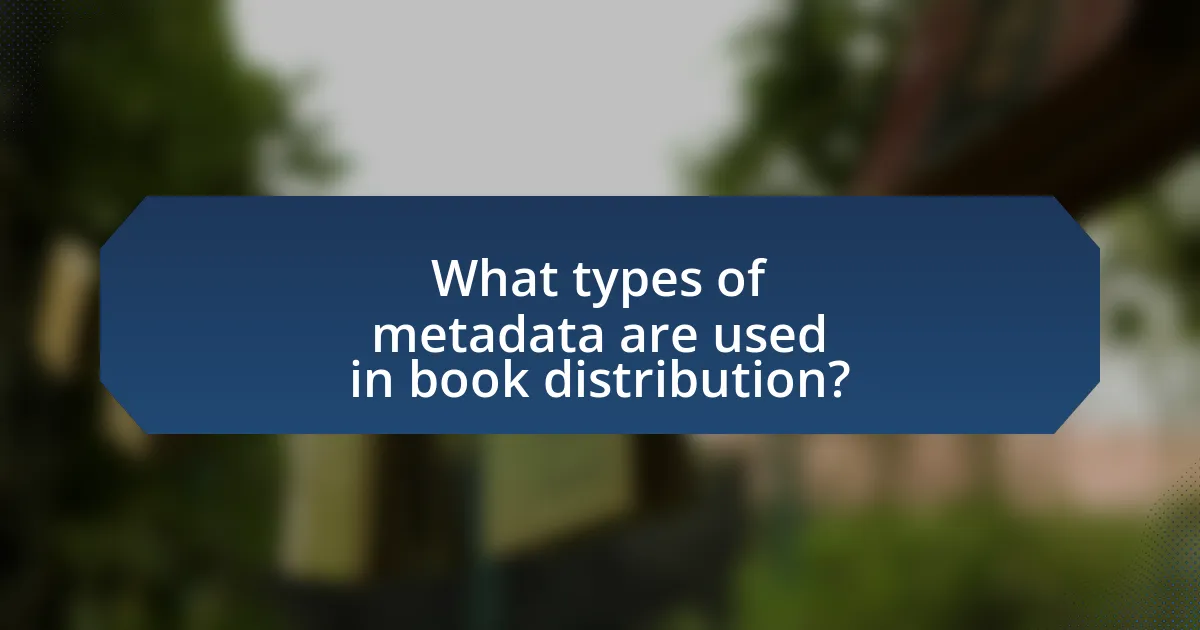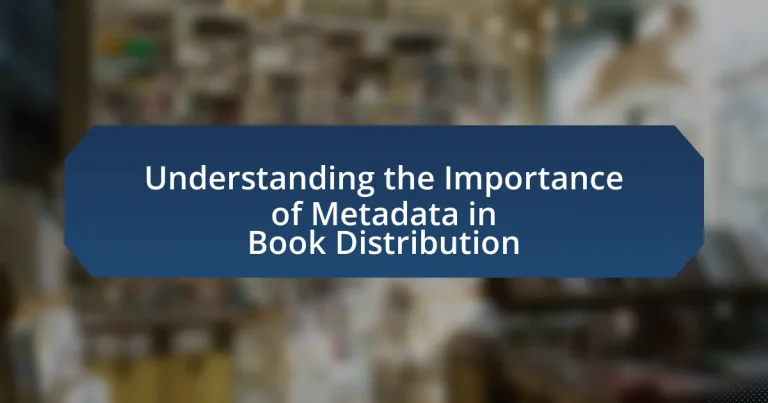Metadata in book distribution is the structured information that describes a book’s content, format, and essential details necessary for its identification and management within the publishing ecosystem. This article explores the critical role of metadata, including its key elements such as title, author, ISBN, and genre, in enhancing discoverability, inventory management, and sales. It also addresses the various types of metadata, the challenges associated with maintaining accuracy, and best practices for effective metadata management. By understanding the significance of metadata, publishers and authors can improve visibility and accessibility, ultimately driving reader engagement and sales in a competitive market.

What is Metadata in Book Distribution?
Metadata in book distribution refers to the structured information that describes a book’s content, format, and other essential details necessary for its identification and management in the publishing ecosystem. This includes elements such as the title, author, ISBN, genre, publication date, and keywords, which facilitate the book’s discoverability and categorization across various platforms. Accurate metadata is crucial as it enhances searchability, aids in inventory management, and influences sales by ensuring that potential readers can easily find and access the book. According to the Book Industry Study Group, effective metadata can increase a book’s visibility by up to 30%, underscoring its significance in the distribution process.
How does metadata function in the context of book distribution?
Metadata functions as essential information that describes and categorizes books for effective distribution. It includes details such as title, author, genre, publication date, and ISBN, which help retailers, libraries, and distributors identify and manage inventory. Accurate metadata enhances discoverability in online platforms, enabling potential readers to find books through search queries. According to a study by Bowker, 75% of book sales occur through online channels, where metadata plays a crucial role in search engine optimization and visibility. Thus, well-structured metadata directly influences sales and accessibility in the book distribution ecosystem.
What are the key elements of metadata for books?
The key elements of metadata for books include title, author, ISBN, publication date, genre, and description. Title identifies the book, while the author denotes the creator. The ISBN serves as a unique identifier for the book, facilitating its tracking and sales. Publication date indicates when the book was released, and genre categorizes the book within a specific literary classification. Description provides a summary of the book’s content, aiding in marketing and discovery. These elements are essential for effective book distribution and help retailers and libraries manage inventory and assist readers in finding relevant titles.
How does metadata impact the discoverability of books?
Metadata significantly impacts the discoverability of books by providing essential information that helps readers and search engines locate titles. Effective metadata includes details such as the book’s title, author, genre, keywords, and descriptions, which enhance searchability in online databases and retail platforms. For instance, a study by the Book Industry Study Group found that 70% of book purchases are influenced by online searches, underscoring the importance of accurate and comprehensive metadata in connecting potential readers with relevant titles.
Why is metadata crucial for publishers and authors?
Metadata is crucial for publishers and authors because it enhances discoverability and provides essential information about a book. This structured data, including title, author, genre, and keywords, enables effective categorization and indexing in databases and online platforms. According to a study by the Book Industry Study Group, 70% of book sales are influenced by metadata, highlighting its role in driving visibility and sales. Additionally, accurate metadata ensures that readers can find relevant content easily, thereby improving the overall reading experience and increasing the likelihood of purchase.
What role does metadata play in sales and marketing strategies?
Metadata plays a crucial role in sales and marketing strategies by enhancing discoverability and targeting of products. In the context of book distribution, metadata includes essential information such as title, author, genre, and keywords, which help retailers and consumers find books more easily. According to a study by Bowker, 70% of book buyers rely on metadata to make purchasing decisions, highlighting its significance in influencing sales. Furthermore, effective metadata management allows publishers to optimize their marketing campaigns by tailoring content to specific audience segments, thereby increasing engagement and conversion rates.
How does effective metadata enhance reader engagement?
Effective metadata enhances reader engagement by providing accurate and relevant information that helps readers discover content that meets their interests. When metadata is well-structured, it includes essential details such as keywords, categories, and descriptions that improve searchability and visibility in digital platforms. For instance, a study by the Book Industry Study Group found that 70% of readers rely on metadata to find new books, indicating that effective metadata directly influences their decision-making process. This connection between metadata and reader engagement underscores the importance of optimizing metadata for better content accessibility and user experience.

What types of metadata are used in book distribution?
The types of metadata used in book distribution include bibliographic metadata, descriptive metadata, structural metadata, administrative metadata, and rights metadata. Bibliographic metadata provides essential information such as the title, author, ISBN, and publication date, which are crucial for cataloging and searching. Descriptive metadata offers details about the content, including genre, keywords, and summaries, aiding in discoverability. Structural metadata outlines the organization of the book, such as chapters and sections, facilitating navigation. Administrative metadata encompasses information related to the management of the book, including file formats and preservation details. Rights metadata specifies copyright information and licensing terms, ensuring legal compliance in distribution. Each type of metadata plays a vital role in the efficient distribution and management of books in the publishing industry.
What are the different categories of metadata?
The different categories of metadata include descriptive metadata, structural metadata, administrative metadata, and preservation metadata. Descriptive metadata provides information about the content, such as title, author, and keywords, facilitating discovery and identification. Structural metadata indicates how different components of a resource are organized, such as chapters in a book. Administrative metadata includes information necessary for managing a resource, such as rights and permissions, while preservation metadata contains details about the preservation process and the history of the resource. Each category plays a crucial role in the effective distribution and management of books, ensuring that they are easily accessible and properly maintained.
How do descriptive metadata and administrative metadata differ?
Descriptive metadata and administrative metadata differ primarily in their functions and content. Descriptive metadata provides information about the content of a resource, such as title, author, and subject matter, facilitating discovery and identification. In contrast, administrative metadata includes details necessary for managing the resource, such as creation date, file type, and rights information. This distinction is crucial in book distribution, as descriptive metadata enhances visibility and accessibility, while administrative metadata ensures proper management and compliance with copyright regulations.
What is the significance of technical metadata in book distribution?
Technical metadata is significant in book distribution because it provides essential information about the digital format, structure, and technical specifications of a book, enabling efficient processing and delivery. This type of metadata includes details such as file type, encoding, and layout, which are crucial for ensuring compatibility across various platforms and devices. For instance, accurate technical metadata allows distributors to optimize file formats for e-readers, ensuring that the content displays correctly and enhances user experience. Furthermore, according to the International Digital Publishing Forum, proper technical metadata can improve discoverability and accessibility, leading to increased sales and readership.
How does metadata vary across different book formats?
Metadata varies significantly across different book formats, impacting how books are categorized, discovered, and distributed. For instance, print books typically include metadata such as ISBN, author name, publication date, and genre, which are essential for physical inventory management and sales tracking. In contrast, eBooks often incorporate additional metadata elements like file format, digital rights management (DRM) status, and device compatibility, which are crucial for digital distribution platforms. Audiobooks, on the other hand, may include metadata related to audio quality, narration details, and listening duration, which are important for user experience and accessibility. This variation in metadata is essential for optimizing searchability and ensuring that books reach their intended audience effectively.
What unique metadata considerations exist for eBooks?
Unique metadata considerations for eBooks include the need for specific identifiers, such as ISBNs and ASINs, which are essential for tracking and sales. eBooks also require detailed formatting metadata, including file type, DRM status, and accessibility features, to ensure compatibility across various devices and platforms. Additionally, eBooks benefit from enhanced metadata elements like keywords and categories that improve discoverability in online marketplaces. According to the International Digital Publishing Forum, proper metadata management can significantly increase an eBook’s visibility and sales potential, highlighting the importance of these unique considerations in the digital book distribution landscape.
How does print book metadata differ from audiobook metadata?
Print book metadata primarily includes information such as the title, author, ISBN, publication date, and physical attributes like page count and dimensions, while audiobook metadata focuses on details like narrator, audio format, duration, and file size. The distinction arises because print books are tangible products requiring specifications relevant to physical distribution, whereas audiobooks are digital products necessitating data pertinent to audio playback and digital rights management. For instance, the inclusion of narrator information in audiobook metadata is crucial for consumer choice, as studies show that the narrator’s voice can significantly influence listener engagement and satisfaction.

What challenges are associated with metadata in book distribution?
Challenges associated with metadata in book distribution include inconsistency, lack of standardization, and data quality issues. Inconsistency arises when different publishers or distributors use varying formats or terminologies for metadata, leading to confusion and inefficiencies in cataloging and searching for books. The lack of standardization means that there is no universally accepted set of guidelines for metadata creation, which can result in incomplete or inaccurate information being provided. Data quality issues often stem from human error during data entry or outdated information, which can mislead retailers and consumers. According to a study by the Book Industry Study Group, poor metadata can lead to a significant loss in sales, highlighting the critical need for accurate and consistent metadata in the book distribution process.
What common issues do publishers face with metadata accuracy?
Publishers commonly face issues with metadata accuracy, including inconsistent data entry, outdated information, and lack of standardization across platforms. Inconsistent data entry occurs when different team members input information differently, leading to discrepancies. Outdated information arises when publishers fail to update metadata after changes, such as title revisions or author name changes. Additionally, the lack of standardization across various distribution platforms can result in variations in how metadata is formatted and presented, complicating the distribution process. These issues can negatively impact discoverability and sales, as accurate metadata is crucial for effective book distribution.
How can incorrect metadata affect a book’s performance?
Incorrect metadata can significantly hinder a book’s performance by affecting its discoverability and sales. When metadata such as title, author name, genre, or keywords is inaccurate, potential readers may struggle to find the book through search engines or online retailers. For instance, a study by the Book Industry Study Group found that 70% of readers discover books through online searches, highlighting the critical role of accurate metadata in connecting books with their audience. Furthermore, incorrect metadata can lead to misclassification, resulting in the book being placed in irrelevant categories, which diminishes its visibility and appeal to the target audience.
What are the implications of outdated metadata?
Outdated metadata can lead to significant issues in book distribution, including reduced discoverability and inaccurate representation of the book’s content. When metadata is not updated, potential readers may struggle to find the book through search engines or online retailers, resulting in lower sales. Additionally, outdated information can mislead readers regarding the book’s genre, author, or publication date, which can damage the author’s reputation and affect reader trust. According to a study by the Book Industry Study Group, 70% of consumers rely on metadata to make purchasing decisions, highlighting the critical role accurate metadata plays in the success of a book.
How can publishers improve their metadata practices?
Publishers can improve their metadata practices by implementing standardized metadata frameworks such as ONIX for Books, which enhances data consistency and interoperability across platforms. By adopting these standards, publishers ensure that their metadata is comprehensive, accurate, and easily accessible, which is crucial for effective book distribution. Research indicates that accurate metadata can increase discoverability by up to 30%, directly impacting sales and reader engagement. Furthermore, regular audits and updates of metadata can help maintain its relevance and accuracy, ensuring that it reflects current market trends and consumer preferences.
What tools and resources are available for managing metadata?
Tools and resources available for managing metadata include metadata management software, digital asset management systems, and content management systems. Metadata management software, such as Apache Atlas and Talend, allows organizations to catalog, manage, and govern their metadata effectively. Digital asset management systems like Adobe Experience Manager and Bynder provide centralized repositories for storing and organizing digital assets along with their associated metadata. Content management systems, such as WordPress and Drupal, offer built-in features for managing metadata related to web content. These tools enhance the efficiency of metadata handling, ensuring accurate and consistent data across platforms, which is crucial for effective book distribution.
How can collaboration with distributors enhance metadata quality?
Collaboration with distributors enhances metadata quality by facilitating the exchange of accurate and comprehensive information about books. Distributors possess insights into market trends and consumer preferences, which can inform the creation of more relevant metadata. For instance, when publishers work closely with distributors, they can receive feedback on how metadata impacts sales performance, allowing for adjustments that improve discoverability. Additionally, distributors often have established standards for metadata formatting and content, ensuring consistency and accuracy across platforms. This collaboration leads to higher-quality metadata, which is crucial for effective book distribution and visibility in a competitive market.
What best practices should be followed for effective metadata management?
Effective metadata management requires the implementation of standardized metadata schemas, regular audits, and comprehensive training for staff. Standardized schemas, such as Dublin Core or ONIX for books, ensure consistency and interoperability across platforms, facilitating better discoverability. Regular audits help identify gaps or inaccuracies in metadata, which can significantly impact searchability and sales. Comprehensive training equips staff with the necessary skills to create and maintain high-quality metadata, ultimately enhancing the overall effectiveness of metadata management in book distribution.
How often should metadata be reviewed and updated?
Metadata should be reviewed and updated at least annually. Regular reviews ensure that the information remains accurate and relevant, reflecting any changes in the book’s content, market conditions, or distribution channels. According to industry standards, such as those outlined by the International Digital Publishing Forum, frequent updates can enhance discoverability and sales, as outdated metadata can lead to missed opportunities in the competitive book market.
What strategies can be implemented to ensure consistency in metadata?
To ensure consistency in metadata, organizations should implement standardized metadata schemas and guidelines. Standardization allows for uniformity in data entry, which minimizes discrepancies and enhances interoperability across systems. For instance, adopting established standards like Dublin Core or ONIX for books provides a framework that all contributors can follow, ensuring that metadata is consistently formatted and complete. Additionally, regular training for staff on these standards and periodic audits of metadata entries can help identify and rectify inconsistencies, thereby maintaining high-quality metadata over time.





